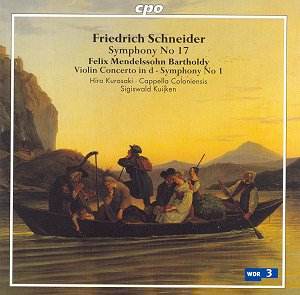On 7 April 1805 Beethoven's
Eroica Symphony got its first performance
during a concert in Vienna. At the same
concert another symphony in E flat was
performed, composed by Anton Eberl (1765
- 1807). Public and critics alike thought
Eberl's symphony the better of the two.
We know what happened: Eberl's symphony
fell into oblivion (until it was recorded
by Concerto Köln), whereas Beethoven's
Eroica turned into one of the most popular
of his compositions. This shows how
different the assessment of composers
and their music can be from one time
to another.
The present disc presents
another forgotten master of the early
19th century: Johann Christian Friedrich
Schneider. He took piano lessons from
his father, Johann Gottlob (1753 - 1840).
In 1798 he entered the Zittau Gymnasium
and soon started to compose his first
works. In 1804 he published three keyboard
sonatas. In 1805 he entered Leipzig
University, and in 1807 he was appointed
organist of the Universitätskirche.
In 1812 he became organist of the St
Thomas's Church, in 1816 conductor of
the Singakademie and in 1817 director
of the city theatre. His future seemed
to be in Leipzig, but his life took
a turn when he accepted the post of
Hofkapellmeister at the court of Anhalt-Dessau.
There he played an important role in
the building up of musical life: he
founded a Singakademie, a Liedertafel
and a music school. He was also a renowned
teacher: one of his pupils was the German
composer Robert Franz (1815 - 1892).
Schneider had a reputation as a pianist,
as is demonstrated by the fact that
he gave what was probably the first
performance of Beethoven's 5th Piano
Concerto in Leipzig in 1811. His compositional
output is pretty large and varied, as
he wrote symphonic works, but also masses
and operas. One of the features of the
Symphony No. 17 played here (which was
the third he wrote in Dessau) is its
instrumentation. Especially in the first
movement the wind instruments play a
prominent role, giving a particular
colouring to this movement. The wind
players of the orchestra are very impressive
here. This symphony also contains pretty
strong dynamic contrasts, which are
not realised to their full extent. The
tempo of the second movement - andante
- is a little too slow, and the menuet
could have been more playful. As well
as the orchestra is playing I have the
feeling that not all the symphony's
qualities are delivered here. But the
performance is good enough to suggest
that Schneider's music is really worth
to be explored further.
The other two works
are by Mendelssohn, one generation younger
than Schneider, and also a man of reputation
in his time, both as a composer and
as a performer. He was widely admired
for his skills at the piano, but he
was equally accomplished on the violin.
The violin concerto recorded here dates
from 1822, from the same period in which
Mendelssohn wrote his symphonies for
strings. Like these this violin concerto
was intended to be played at the Sunday
concerts at the Mendelssohn home. It
is possible that Mendelssohn played
the solo part himself, but it could
also have been performed by his friend
Ferdinand David, for whom he later composed
his now much more famous Violin Concerto
op. 64. This concerto begins with an
allegro molto which reminds of the symphonies
of Carl Philipp Emanuel Bach, whose
influence also shines through in the
string symphonies and whose music Mendelssohn
got familiar with through his teacher
Carl Friedrich Zelter, a great admirer
of the 'Hamburg Bach'. The second movement
is a real romantic piece, with a beautifully
shaped melodic line over a tapestry
of strings, creating a wonderful warm
and intimate mood. The last movement
is a joyful piece with a folkloristic
character.
Hiro Kurosaki give
a first-class performance, producing
a beautiful clear sound, using minimal
vibrato. Both the romantic mood of the
second movement and the joyful and sparkling
last movement are realised perfectly
here by soloist and orchestra alike.
The last item is the
first symphony for full orchestra with
strings and wind Mendelssohn composed.
It was first performed in 1824. In its
character it is still close to the string
symphonies, and also referring to models
of the past, in this case Mozart, in
particular his Symphony in g minor (KV
550). This symphony gets a very energetic
performance, showing the qualities which
I missed to some extent in the performance
of Schneider's symphony, like the strong
dynamic accents and really convincing
tempi. The wind players are at their
best again in the second movement (there
is also a wonderful solo for the clarinet
in the last movement). The contrast
between menuet and trio (third movement)
is brought out well.
This is a very interesting
recording: Schneider's work is definitely
intriguing, and Mendelssohn gets ideal
performances.
Johan van Veen


